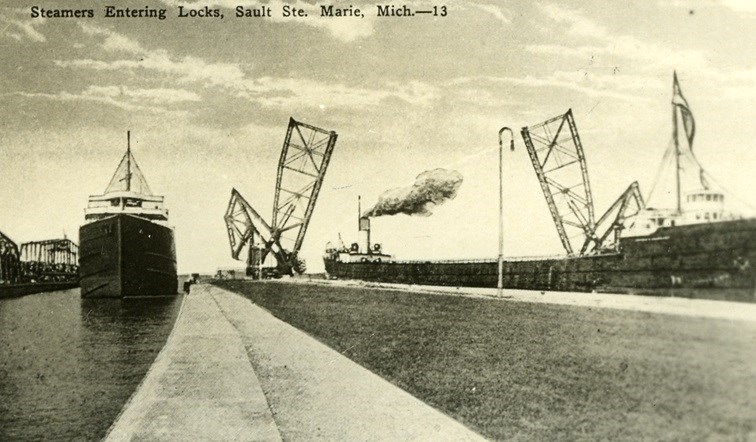From the archives of the Sault Ste. Marie Public Library:
In 1941, disaster hit the Sault Ste. Marie locks when part of the railway bridge spanning the St. Mary’s River collapsed.
On Oct. 7, just prior to 1:40 a.m., a loaded freight train set out from Sault Ste. Marie, Ontario, heading into Michigan. Everything seemed normal until it reached the “jack knife” or bascule part of the bridge – the section that could lift out of the way to allow lake traffic to pass under it.
Later, media speculated that the lift parts of the bridge had not locked into place properly, or that the weight of the train was simply too much for it. Either way, the span buckled, becoming what the Sault Star described as “a twisted mass of steel girders.”
It all seemed to happen slowly, witnesses told the Globe and Mail after the fact. The bridge went into the water of the St. Mary’s River. With it went the train – an engine, tender, and 35 freight cars.
Two of the people aboard the train, a fireman and a brakeman, escaped the debris, swam to the nearby bridge girders, and climbed out of harm’s way; they were rescued by soldiers guarding the canal area. However, despite their best efforts, they were not able to pull the others out of the wreck. The engineer and the conductor were trapped inside the locomotive and drowned.
The collapse stopped all train traffic going across the river. Any passengers needing to cross the river by rail were referred to the ferry instead. As far as freight trains went, delays were anticipated and trains were rerouted, with the dairy, pulpwood, paper, and lumber industries being most affected.
However, the disaster also affected marine traffic.
When the train hit the water, it sank to the bottom of the river and blocked two of the four locks that were then in operation at the canal. To make matters worse, the two functioning locks were the smaller ones – the American Poe lock and the Canadian lock – and were not able to handle many of the cargo ships waiting to pass through.
Within twenty minutes of the train hitting the water, U.S. Coast Guard ships were on scene, directing boats through the locks. However, while they could help ships of the appropriate size navigate safely, there was little they could do about the rest of the freighters, too large to go through the only working locks.
After two days, fifty ships were waiting for the canal to be cleared so that they could continue on their way. Officials were concerned it could get significantly worse: by the time the third day ended, people feared that as many as 130 ships could be stuck, unable to pass through the locks.
It was, according to the Sault Star, “the height of the busiest season the Great Lakes have ever known,” with almost all serviceable ships out on the water. With the Second World War underway, this delay sparked concerns about the ramifications it could have on the war effort – especially when it came to iron, which an editorial in the Sault Star referred to as “the metal of victory.”
An emergency order went out for ships being loaded to reduce the cargo they were carrying; any ships hoping to pass through Sault Ste. Marie had to meet the requirements of the smaller locks, reducing what they carried by as much as half of their normal load. Ships out on the water were given the option to drop anchor and wait, or reduce their loads in order to continue. Authorities opened the compensation dams on the locks, raising the river by two feet, allowing boats with a greater draft to pass through the locks safely.
Crews, including divers, worked to recover the bodies of the two deceased and to move the train wreckage away from shipping channels. However, it had landed at an awkward angle, making it impossible to reach the bodies without first rolling and repositioning the train.
Attempts to drag the locomotive out of the way were slow and painstaking. The two-inch cable used to pull the train along snapped three times, setting crews back and making it difficult to move the train from its resting place. However, one lock was soon clear enough to allow traffic through, and the other lock followed. The mangled locomotive finally made it out of the water on Oct. 11, and the locks fully reopened.
Due to its timing, people immediately feared that the bridge had been sabotaged, leading to its collapse. However, the F.B.I. soon released a statement saying there was no indication that the bridge had been destroyed through sabotage.
Today, the incident remains one of the significant accidents in the history of the locks – and a clear illustration of what a critical shipping artery the canal area is.
Each week, the Sault Ste. Marie Public Library and its Archives provides SooToday readers with a glimpse of the city’s past.
Find out more of what the Public Library has to offer at www.ssmpl.ca and look for more Remember This? columns here
